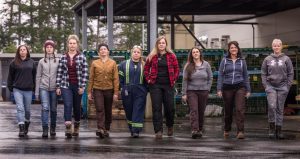
The Women in Trades Training (WITT) at Camosun College initiative is part of a long-term strategy to match women’s skills to the needs of BC’s workplace. @camosun.ca
BRITISH COLUMBIA – While the number of women getting involved in the construction industry has been increasing steadily, there’s still plenty of room to grow as opportunities continue to expand.
Statistics released by the B.C. Construction Association (BCCA) in their 2024 Spring Stat Pack shows that 9,536 women are currently working in the construction trades, which is 5.7 percent of the total workforce. This reflects a 24 percent increase over the past five years.

Seema Lal, President of Canadian Construction Women
Seema Lal, President of Canadian Construction Women, says “The good news is that the percentage of women in construction is increasing overall; the bad news is that the rate of this increase is not high enough to keep pace with the attrition we are seeing with employment in construction more generally.
“In their February, 2024 report, BuildForce Canada reported that, as compared with 2023, the construction labour force contracted by 23,600 workers (or -1.4%), while there was a 1.6% increase from 2023 in the number of women employed in the construction sector.“
Typical obstacles like stereotypes and stigma about a career in construction trades continues to be a barrier to recruiting more women, according to Rory Kulmala, CEO of the Vancouver Island Construction Association.
“As an industry, we’ve made strides in dispelling some stereotypes while creating more inviting workplaces for women and underrepresented groups,” states Kulmala. “Where we could do more is at the middle and high school level, introducing the trades as a viable career path for both women and young people in general. Unfortunately, we are seeing underinvestment in shop-class facilities in our public schools which is robbing students of the enriching experience that shop classes provide.
“Without an early introduction to the trades and a continuous push towards university, recruiting women into the trades will always be an uphill battle.”
Electrician and carpenter are the two most popular trades for women, which mirrors the most favorable for men.
“These numbers do not include non-registered trades or positions, such as safety officers or skilled labour positions, which makes it difficult to directly point to the most popular trade for women,” Kulmala says. “What we can say with confidence is there are numerous opportunities for women to enter the trades with positions that complement their individual interests and physical abilities.

“From our experience, employers that prioritize an equitable, safe, and harassment-free workplace are going to find the most success with employing and retaining female employees.”
Lal points out that “Women tend to be more heavily represented in administrative/project management roles in construction. The environment on a construction site, including the lack of accessible female-focussed hygiene options and the male-dominant culture, remain a challenge for women seeking to pursue positions that require onsite presence.”
More women could be encouraged to join the industry through more education and a shift in the mindset towards trades in general, starting at the grade school level, she adds.
“There is a myriad of lucrative and rewarding employment/business options for women in this sector is essential to encouraging more women to consider a job in this fantastic and profitable sector. More flexibility in working conditions is also a key factor, given that women continue to be the primary caregiver for children and aging parents.”
Kulmala adds that through the network of BC’s regional construction associations, labour federations, trade schools, SkilledTradesBC, and recruitment initiatives, there are numerous programs for women who are new to the workforce, considering switching their careers to the trades or looking to advance their current careers through the apprenticeship process.
“Most recently, the BC Construction Association concluded its Apprenticeship Services program, which included a financial incentive for BC construction employers to hire and register female first-year apprentices,” he points out.
That program concluded earlier this year, after distributing $15.725M in financial incentives for small and medium-sized construction employers. Additionally, programs like VICA’s Construct Your Future program and Camosun College’s Women in Trades Training program are critical to exposing more women to a career in the trades and are an excellent pathway to having more women join the construction workforce.
“We are also very fortunate to have an excellent relationship with the BC Centre for Women in the Trades (BCCWITT), who provide a full portfolio of support, training, and financial resources for individuals and employers to support their current workforce and attract more women and other underrepresented groups to the construction trades,” he says.
By Mark MacDonald

